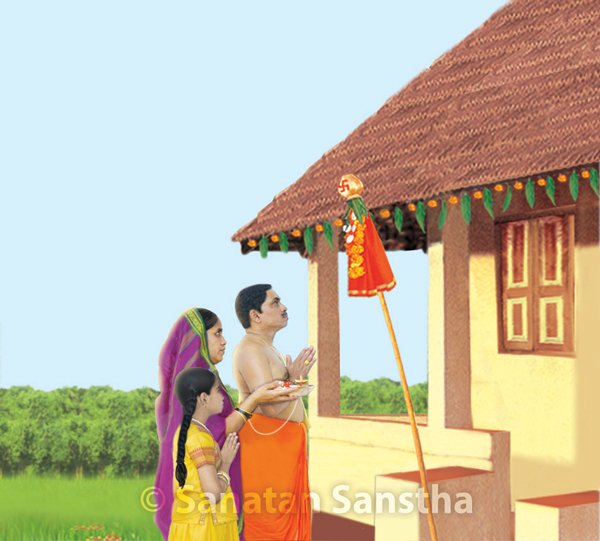Chaitra Shukla Pratipada is the day on which the Universe was created; hence, this is the real commencement of the New Year. The cycle of the year that begins with Gudi Padwa is related to the time that the Universe was first created and therefore nature is vibrant with life

Tithi (Lunar day) of the festival: Yugadi tithi, Chaitra Shukla Pratipada (First day of the bright fortnight of the Hindu lunar month of Chaitra). There are several ways of commencing a new year – in the Christian calendar 1st January marks the beginning of the year, the financial year in Bharat begins from 1st April, the Hindu new year from Chaitra Shukla Pratipada, the commercial year from the first day of the Hindu lunar month of Kartik, the solar year, the lunar year, the lunisolar year and so on. Irrespective of the day of commencement, the year comprises twelve months. Who first proclaimed that a year should consist of twelve months and how did the world come to accept it? The Vedas (The most sacred Hindu scriptures) are the foremost in promoting this concept. There is no difference of opinion that Vedas are the most ancient of literary texts. The Vedas say Dwadashmase Sanwantsar meaning ‘a year consists of twelve months’. It is because the Vedas say so that the world has accepted it. Of all the days mentioned above, the most ideal is that of Chaitra Shukla Pratipada. There is no explanation as to why 1st of January is the beginning of the New Year. Someone decided this, and it began. Contrary to this there are natural, historical and spiritual reasons to mark the commencement of the year on Chaitra Shukla Pratipada.
Natural
Towards the first day of the month of Chaitra (Padva), the sun assumes a position above the Vasant intersection (the point of intersection of the Equator and the Meridians) and the spring season commences. In Srimadbhagvadgita (10.35) Shrikrushna says, “Amongst the seasons the exhilarating Vasant rutu (spring) is my manifestation.” In this season, the weather is pleasant and exhilarating. In the Shishir rutu (autumn) the trees shed their leaves. Towards Padwa, trees bear new foliage and appear fresh.
Historical
1. On this day, Shriram killed Vali.
2. The Shakas too gained victory by defeating the Huns.
3. This day also commemorates the commencement of the ‘Shalivahan shak’; for, on this day King Shalivahan vanquished his enemies.
Spiritual
Creation of the Universe: Deity Brahma created the Universe on this day, which marked the beginning of Satyayug (the first in the cycle of four eras since the origin of the Universe); hence, the commencement of the New Year on this day. Not 1st January, but Gudi Padwa is truly the New Year day.
The cycle of the year that begins with Gudi Padwa is related to the time that the Universe was first created and therefore nature is vibrant with life. On the contrary, the year beginning from the midnight of 31st December is related to the period of destruction. The New Year beginning on the day of Gudi Padwa can be compared to a radiant day brought by a new sunrise.
The New Year after 31st December is like the night which follows a sunset, filled with the tama component. Man benefits by following the rules of nature and is actually harmed by going against it. Hence, it is beneficial to celebrate the New Year on Gudi Padwa, rather than 31st December night as per western culture.
One among the three and a half muhurts (Auspicious time), Gudi Padwa, Akshay Trutiya and Dussehra (Vijayadashmi) each make up one, and the first day of the Hindu lunar month of Kartik comprises one-half of the total three and a half muhurts. The special feature of these three and a half muhurts is that unlike other days, when one has to choose an auspicious moment to perform a ritual, on these days one does not need to, as every moment of these days is auspicious.
Approach to celebration
On Gudi Padwa, one should wake up early in the morning and take a bath, that is a sabhyang snan (Manglik snan). After a bath we should decorate the lintel of every door with a toran. Red flowers are used because red colour symbolises auspiciousness. First puja is performed as a routine ritual. A Mahashanti is performed on the New Year’s day. The Mahashanti begins with the worship of Deity Brahma as He created the Universe on this day. Then Shrivishnu, who manifests Himself in countless forms is worshipped. It is said that by performing this Mahashanti one is cleansed of all sins, no new sins are generated, the lifespan is increased and one becomes wealthy. The needy should be given different kinds of offerings. For example offering free drinking water by setting up a stall. This appeases the ancestors. Perform puja and listen to the narration of the panchang from the astrologer or priest, meaning, benefits of the coming year.
The Gudi (or the Brahma-dhwaj) is hoisted in every house as a symbol of victory and happiness. Since a symbol of victory is always held high, so is the Gudi. Since neem has the highest ability to absorb Prajapati frequencies as compared to any other substance, its leaves are partaken as prasad on this day. On this day fields should be ploughed. Ploughing churns the soil. The subtle soil particles get charged with the Prajapati waves and its ability to germinate seeds increases manifold. To get maximum benefit of God’s blessings, wish Hindus and others on Chaitra Shukla Pratipada by sending them greeting cards (by mail, E-mail), SMS etc. and telephonically! Best Wishes to all on the Hindu New Year (Gudi Padwa/Ugadi)!
(This article is produced by Sanatan Sanstha)